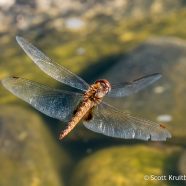Spot-winged Glider
I finally captured a Spot-winged Glider (Pantala hymenaea) on the wing, and in this case it while the dragonfly was ovipositing – laying eggs in this pool. You can clearly see the basal spots on the inside of the hindwings along with some wear. Flying around the world must get a bit tiring… Scott Kruitbosch Conservation & Outreach Coordinator
Read MoreBlue Jay
This Blue Jay (Cyanocitta cristata) was in the shade on a sunny April day, nevertheless showing off blue hues against a blue sky and flying around with its mate. In this case the blues are not as blue as they could be because they are not actually blue. Huh? Their feather barb cells are specially modified scatter light in a way that makes them appear blue instead of what would be brown melanin, and if this bird flew into the sunlight then it would pop even more. Scott Kruitbosch Conservation & Outreach Coordinator
Read MoreDwarf Glass Frog (Teratohyla spinosa)
Do you know what color a frog’s bones are? Well, in this case, you can tell us! Check out this Dwarf Glass Frog (Teratohyla spinosa) and you can see the green bones along with the rest of its internal anatomy. Photographed by RTPI President Twan Leenders in Costa Rica.
Read MoreSnowy Owl Fly-by
This Snowy Owl photo is from earlier this winter, and I’m still imagining how wonderful it would be if this fly-by bird had simply looked at me. It was a short flight from one spot to another by our resident friend, and I suppose I was too boring and non-threatening for it to focus on. Still, it’s a cool look at parts of the Snowy we do not often get to see, with those talons tucked under the very feathery and incredibly insulated body. Scott Kruitbosch Conservation & Outreach Coordinator
Read MoreCochranella granulosa
RTPI Affiliate Sean Graesser always wanted to photograph a glass frog like this, and on the recent trip to Panama he decided to give it a shot with this beautiful Cochranella granulosa. Can you see why they’re called glass frogs?
Read More








